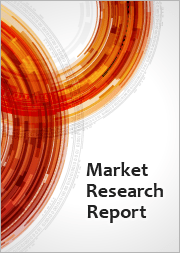
|
시장보고서
상품코드
1636357
자동 라디오 신디시스 모듈 시장 보고서 : 유형별, 용도별, 지역별(2025-2033년)Automated Radiosynthesis Module Market Report by Type (Fully Automated, Semi-Automated), Application (Hospitals, Diagnostic Labs, Radiology Clinics, and Others), and Region 2025-2033 |
||||||
세계의 자동 라디오 신디시스 모듈 시장 규모는 2024년 3,600만 달러에 달했습니다. IMARC Group은 향후 시장이 2033년까지 5,940만 달러에 이를 전망이며, 2025년부터 2033년까지 성장률(CAGR)은 5.43%가 될 것으로 예측했습니다. 다양한 만성 질환 및 심혈관 질환, 특히 노년 인구에서의 유병률 증가, 단층 영상을 만드는 의료 분야에서 PET 및 SPECT 스캐너의 요구가 증가하고, 의료 분야에서의 진보는 시장을 견인하는 중요한 요소 중 하나입니다.
자동 라디오 신디시스 모듈은 집중 진단 및 치료 절차를 수행하기에 적합한 추적자 분자로 방사성 동위 원소를 조합하도록 설계된 고급 의료기기를 말합니다. 자동 라디오 신디시스 모듈은 양전자 방사 단층촬영(PET) 및 단광자 방사 컴퓨터 단층촬영(SPECT) 스캐너를 채택합니다. 이러한 솔루션은 단층 이미징 방법의 유용성을 향상시킵니다. 방사성 트레이서 및 방사성 의약품 단위와 비교하면 제조 사용자 정의, 장비 수명 연장, 설치 편의성, 진단 및 치료 관리 중 작업 효율 향상을 기대할 수 있습니다. 이 외에도 자동 라디오 신디시스 모듈은 즉시 사용할 수 있으며 치료 모니터링 활동을 향상시킵니다. 그 결과 병원, 연구소, 진료소 등 의료 관계자에게 널리 사용되고 있습니다. 현재, 자동 라디오 신디시스 모듈은 전자동 유형 및 반자동 유형이 시판되고 있습니다.
자동 라디오 신디시스 모듈 시장 동향 :
암과 만성 폐색성 폐 질환(COPD)을 포함한 다양한 만성 질환 및 심혈관 질환의 유병률 증가는 시장 성장을 가속하는 주요 요인입니다. 또한, 단층 영상을 만들기 위한 PET나 SPECT 스캐너의 요구가 의료 분야에서 높아지고 있는 것이, 자동 라디오 신디시스 모듈 수요를 촉진하고 있으며 이것도 성장을 가속하는 요인이 되고 있습니다. 이에 따라 여러 정부가 분산 환경에서 방사선 추적기 생산에 대규모 투자를 하고 있는 것도 시장 성장에 더욱 기여하고 있습니다. 또한 저자본 비용, 최소한의 인프라 요구 사항, 최적의 성능 등 여러 제품의 이점에 대한 의식이 높아져 시장 성장을 지원합니다. 이것은 또한 사용법, 기능 및 효능 측면에서 현저한 기술 진보가 있으며 시장 성장에 상당히 유리한 것으로 예상됩니다. 또한 만성 질환에 걸리기 쉬운 노년 인구 증가와 세계 사망률의 상승이 시장 성장을 뒷받침하고 있습니다. 기타 요인으로는 의료 인프라의 대폭적인 발전, 최근 연구개발(R&D) 활동, 효율성을 높인 대체 신제품 개발을 위한 주요 기업 간의 주요 전략적 제휴 등이 있어 시장 성장에 밝은 전망을 가져오고 있습니다. 또한 의료산업의 대폭적인 확대와 다양한 용도로의 자동 라디오 신디시스 모듈의 채용을 장려하기 위해 정부와 민간 단체가 제공하는 자금과 보조금도 시장을 견인하고 있습니다.
이 보고서에서 다루는 주요 질문
- 세계의 자동 라디오 신디시스 모듈 시장은 지금까지 어떻게 추이하고 향후 어떻게 추이해 나갈 것인가?
- 세계의 자동 라디오 신디시스 모듈 시장에서 촉진요인, 억제요인 및 기회는?
- 주요 지역 시장은?
- 가장 매력적인 자동 라디오 신디시스 모듈 시장은 어느 국가인가?
- 유형별 시장 내역은?
- 용도별 시장 내역은?
- 세계 자동 라디오 신디시스 모듈 시장의 경쟁 구도는?
- 세계의 자동 라디오 신디시스 모듈 시장에서 주요 업체 및 기업은?
목차
제1장 서문
제2장 조사 범위 및 조사 방법
- 조사의 목적
- 이해관계자
- 데이터 소스
- 1차 정보
- 2차 정보
- 시장 추정
- 상향식 접근
- 하향식 접근
- 조사 방법
제3장 주요 요약
제4장 서문
- 개요
- 주요 업계 동향
제5장 세계의 자동 라디오 신디시스 모듈 시장
- 시장 개요
- 시장 실적
- COVID-19의 영향
- 시장 예측
제6장 시장 내역 : 유형별
- 전자동
- 시장 동향
- 시장 예측
- 반자동
- 시장 동향
- 시장 예측
제7장 시장 내역 : 용도별
- 병원
- 시장 동향
- 시장 예측
- 진단 실험실
- 시장 동향
- 시장 예측
- 방사선 클리닉
- 시장 동향
- 시장 예측
- 기타
- 시장 동향
- 시장 예측
제8장 시장 내역 : 지역별
- 북미
- 미국
- 캐나다
- 아시아태평양
- 중국
- 일본
- 인도
- 한국
- 호주
- 인도네시아
- 기타
- 유럽
- 독일
- 프랑스
- 영국
- 이탈리아
- 스페인
- 러시아
- 기타
- 라틴아메리카
- 브라질
- 멕시코
- 기타
- 중동 및 아프리카
제9장 촉진요인, 억제요인 및 기회
- 개요
- 성장 촉진요인
- 성장 억제요인
- 기회
제10장 밸류체인 분석
제11장 Porter's Five Forces 분석
- 개요
- 구매자의 협상력
- 공급기업의 협상력
- 경쟁도
- 신규 참가업체의 위협
- 대체품의 위협
제12장 가격 분석
제13장 경쟁 구도
- 시장 구조
- 주요 기업
- 주요 기업 프로파일
- Eckert & Ziegler Strahlen-und Medizintechnik AG
- Elysia SA
- General Electric Company
- IBA RadioPharma Solutions
- Optimized Radiochemical Applications
- SCINTOMICS Molecular, Applied Theranostics Technologies GmbH
- Synthra GmbH
- Trasis
The global automated radiosynthesis module market size reached USD 36.0 Million in 2024. Looking forward, IMARC Group expects the market to reach USD 59.4 Million by 2033, exhibiting a growth rate (CAGR) of 5.43% during 2025-2033. The increasing prevalence of various chronic and cardiovascular diseases, especially amongst the geriatric population, along with the rising need for PET and SPECT scanners in the healthcare sector to create tomographic images and advancements in the healthcare sector represent some of the key factors driving the market.
Automated radiosynthesis module refers to advanced medical equipment designed to formulate the radioactive isotope with a tracer molecule that is suitable to perform intensive diagnostic and therapeutic procedures. The automated radiosynthesis module also employs positron emission tomography (PET) and single-photon emission computerized tomography (SPECT) scanners. These solutions improve the utility of tomographic imaging diagnostics methods. As compared to radiotracers and radiopharmaceutical units, it offers better scope for production customization, longer device life, setting-up convenience, and better operational efficiency while performing diagnosis and therapy administration. Along with this, the automated radiosynthesis module is readily usable and improves therapy monitoring activities. Consequently, it is extensively used across hospitals, laboratories, and clinics by healthcare practitioners. At present, automated radiosynthesis module is commercially available in full and semi-automated types.
Automated Radiosynthesis Module Market Trends:
The increasing prevalence of various chronic and cardiovascular diseases, including cancer and chronic obstructive pulmonary disorders (COPD), represents a prime factor driving the market growth. Additionally, the rising need for PET and SPECT scanners in the healthcare sector to create tomographic images have facilitated the demand for automated radiosynthesis module in the healthcare sector, which is acting as another growth-inducing factor. In line with this, the large-scale investments being made by several governments in the production of radiotracers in decentralized settings are further contributing to the market growth. Moreover, the rising awareness regarding the multiple product benefits, such as low capital cost, minimal infrastructural requirement, and optimal performance, is supporting the market growth. This can be further attributed to significant technological advancements in terms of its usage, features, and efficacy, which is considerably favoring the market growth. Additionally, the rising geriatric population, which is susceptible to chronic ailments, and the escalating mortality rates across the globe are propelling the market growth. Other factors, such as significant enhancements in the healthcare infrastructure, the recent research and development (R&D) activities, and the major strategic collaborations amongst key players to engineer new product alternatives with enhanced efficacy, are creating a positive outlook for the market growth. The market is also being driven by the significant expansion in the healthcare industry, along with funding and grants provided by government and private organizations to encourage the adoption of automated radiosynthesis module for various applications.
Key Market Segmentation:
Type Insights:
- Fully Automated
- Semi-Automated
- The report has also provided a detailed breakup and analysis of the automated radiosynthesis module market based on the type. This includes fully and semi-automated. According to the report, fully automated represented the largest segment.
Application Insights:
- Hospitals
- Diagnostic Labs
- Radiology Clinics
- Others
Regional Insights:
- North America
- United States
- Canada
- Europe
- Germany
- France
- United Kingdom
- Italy
- Spain
- Russia
- Others
- Asia Pacific
- China
- Japan
- India
- South Korea
- Australia
- Indonesia
- Others
- Latin America
- Brazil
- Mexico
- Others
- Middle East and Africa
- The report has also provided a comprehensive analysis of all the major regional markets that include North America (the United States and Canada); Asia Pacific (China, Japan, India, South Korea, Australia, Indonesia, and others); Europe (Germany, France, the United Kingdom, Italy, Spain, Russia, and others); Latin America (Brazil, Mexico, and others); and the Middle East and Africa. According to the report, North America was the largest market for automated radiosynthesis module. Some of the factors driving the North America automated radiosynthesis module market included the increasing prevalence of various chronic and cardiovascular diseases, significant technological advancements, and extensive research and development (R&D) activities.
Competitive Landscape:
- The report has also provided a comprehensive analysis of the competitive landscape in the global automated radiosynthesis module market. Detailed profiles of all major companies have also been provided. Some of the companies covered includes Eckert & Ziegler Strahlen- und Medizintechnik AG, Elysia S.A., General Electric Company, IBA RadioPharma Solutions, Optimized Radiochemical Applications, SCINTOMICS Molecular, Applied Theranostics Technologies GmbH, Synthra GmbH, Trasis, etc.
Key Questions Answered in This Report:
- How has the global automated radiosynthesis module market performed so far and how will it perform in the coming years?
- What are the drivers, restraints, and opportunities in the global automated radiosynthesis module market?
- What are the key regional markets?
- Which countries represent the most attractive automated radiosynthesis module markets?
- What is the breakup of the market based on the type?
- What is the breakup of the market based on the application?
- What is the competitive structure of the global automated radiosynthesis module market?
- Who are the key players/companies in the global automated radiosynthesis module market?
Table of Contents
1 Preface
2 Scope and Methodology
- 2.1 Objectives of the Study
- 2.2 Stakeholders
- 2.3 Data Sources
- 2.3.1 Primary Sources
- 2.3.2 Secondary Sources
- 2.4 Market Estimation
- 2.4.1 Bottom-Up Approach
- 2.4.2 Top-Down Approach
- 2.5 Forecasting Methodology
3 Executive Summary
4 Introduction
- 4.1 Overview
- 4.2 Key Industry Trends
5 Global Automated Radiosynthesis Module Market
- 5.1 Market Overview
- 5.2 Market Performance
- 5.3 Impact of COVID-19
- 5.4 Market Forecast
6 Market Breakup by Type
- 6.1 Fully Automated
- 6.1.1 Market Trends
- 6.1.2 Market Forecast
- 6.2 Semi-Automated
- 6.2.1 Market Trends
- 6.2.2 Market Forecast
7 Market Breakup by Application
- 7.1 Hospitals
- 7.1.1 Market Trends
- 7.1.2 Market Forecast
- 7.2 Diagnostic Labs
- 7.2.1 Market Trends
- 7.2.2 Market Forecast
- 7.3 Radiology Clinics
- 7.3.1 Market Trends
- 7.3.2 Market Forecast
- 7.4 Others
- 7.4.1 Market Trends
- 7.4.2 Market Forecast
8 Market Breakup by Region
- 8.1 North America
- 8.1.1 United States
- 8.1.1.1 Market Trends
- 8.1.1.2 Market Forecast
- 8.1.2 Canada
- 8.1.2.1 Market Trends
- 8.1.2.2 Market Forecast
- 8.1.1 United States
- 8.2 Asia-Pacific
- 8.2.1 China
- 8.2.1.1 Market Trends
- 8.2.1.2 Market Forecast
- 8.2.2 Japan
- 8.2.2.1 Market Trends
- 8.2.2.2 Market Forecast
- 8.2.3 India
- 8.2.3.1 Market Trends
- 8.2.3.2 Market Forecast
- 8.2.4 South Korea
- 8.2.4.1 Market Trends
- 8.2.4.2 Market Forecast
- 8.2.5 Australia
- 8.2.5.1 Market Trends
- 8.2.5.2 Market Forecast
- 8.2.6 Indonesia
- 8.2.6.1 Market Trends
- 8.2.6.2 Market Forecast
- 8.2.7 Others
- 8.2.7.1 Market Trends
- 8.2.7.2 Market Forecast
- 8.2.1 China
- 8.3 Europe
- 8.3.1 Germany
- 8.3.1.1 Market Trends
- 8.3.1.2 Market Forecast
- 8.3.2 France
- 8.3.2.1 Market Trends
- 8.3.2.2 Market Forecast
- 8.3.3 United Kingdom
- 8.3.3.1 Market Trends
- 8.3.3.2 Market Forecast
- 8.3.4 Italy
- 8.3.4.1 Market Trends
- 8.3.4.2 Market Forecast
- 8.3.5 Spain
- 8.3.5.1 Market Trends
- 8.3.5.2 Market Forecast
- 8.3.6 Russia
- 8.3.6.1 Market Trends
- 8.3.6.2 Market Forecast
- 8.3.7 Others
- 8.3.7.1 Market Trends
- 8.3.7.2 Market Forecast
- 8.3.1 Germany
- 8.4 Latin America
- 8.4.1 Brazil
- 8.4.1.1 Market Trends
- 8.4.1.2 Market Forecast
- 8.4.2 Mexico
- 8.4.2.1 Market Trends
- 8.4.2.2 Market Forecast
- 8.4.3 Others
- 8.4.3.1 Market Trends
- 8.4.3.2 Market Forecast
- 8.4.1 Brazil
- 8.5 Middle East and Africa
- 8.5.1 Market Trends
- 8.5.2 Market Breakup by Country
- 8.5.3 Market Forecast
9 Drivers, Restraints, and Opportunities
- 9.1 Overview
- 9.2 Drivers
- 9.3 Restraints
- 9.4 Opportunities
10 Value Chain Analysis
11 Porters Five Forces Analysis
- 11.1 Overview
- 11.2 Bargaining Power of Buyers
- 11.3 Bargaining Power of Suppliers
- 11.4 Degree of Competition
- 11.5 Threat of New Entrants
- 11.6 Threat of Substitutes
12 Price Analysis
13 Competitive Landscape
- 13.1 Market Structure
- 13.2 Key Players
- 13.3 Profiles of Key Players
- 13.3.1 Eckert & Ziegler Strahlen- und Medizintechnik AG
- 13.3.1.1 Company Overview
- 13.3.1.2 Product Portfolio
- 13.3.1.3 Financials
- 13.3.2 Elysia S.A.
- 13.3.2.1 Company Overview
- 13.3.2.2 Product Portfolio
- 13.3.3 General Electric Company
- 13.3.3.1 Company Overview
- 13.3.3.2 Product Portfolio
- 13.3.3.3 Financials
- 13.3.3.4 SWOT Analysis
- 13.3.4 IBA RadioPharma Solutions
- 13.3.4.1 Company Overview
- 13.3.4.2 Product Portfolio
- 13.3.5 Optimized Radiochemical Applications
- 13.3.5.1 Company Overview
- 13.3.5.2 Product Portfolio
- 13.3.6 SCINTOMICS Molecular, Applied Theranostics Technologies GmbH
- 13.3.6.1 Company Overview
- 13.3.6.2 Product Portfolio
- 13.3.7 Synthra GmbH
- 13.3.7.1 Company Overview
- 13.3.7.2 Product Portfolio
- 13.3.8 Trasis
- 13.3.8.1 Company Overview
- 13.3.8.2 Product Portfolio
- 13.3.1 Eckert & Ziegler Strahlen- und Medizintechnik AG
Kindly note that this only represents a partial list of companies, and the complete list has been provided in the report.



















